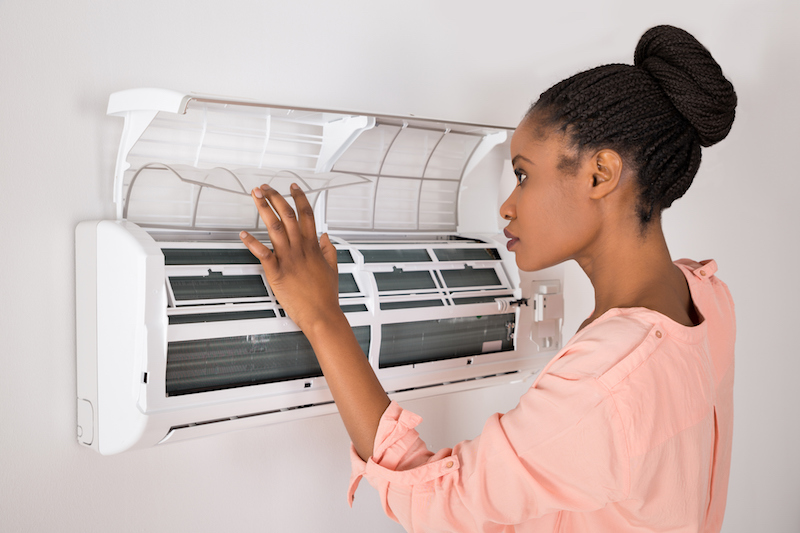
You shouldn’t be forced to give up comfort or empty your wallet to keep your residence at a refreshing temp during warm days.
But what is the best temperature, exactly? We discuss recommendations from energy experts so you can determine the best temperature for your loved ones.
Here’s what we suggest for the most energy-efficient setting for air conditioning in Safford.
Recommended Thermostat Settings for Summer
Most families find setting the thermostat at 72-73 degrees is ideal. However, if there’s a sizeable difference between your inside and outdoor warmth, your electricity expenses will be higher.
These are our recommendations based on the U.S. Department of Energy (DOE) and ENERGY STAR®.
While at home: 78 degrees. While that sounds warm, there are ways you can keep your home cool without having the air conditioning going frequently.
Keeping windows and curtains down during the day keeps chilled air where it needs to be—indoors. Some window treatments, such as honeycomb shades or plantation shutters, are created to deliver extra insulation and enhanced energy savings.
If you have ceiling fans in your home, the DOE says you can move thermostat temps about 4 degrees higher without giving up comfort. That’s because they freshen with a windchill effect. As they cool people, not areas, turn them off when you leave a room.
If 78 degrees still feels too uncomfortable on the surface, try conducting a test for approximately a week. Start by raising your setting to 78 degrees while you’re home. Then, progressively turn it down while adhering to the suggestions above. You might be surprised at how comfortable you feel at a higher temperature setting.
While away: 88 degrees. There’s no reason to keep the air conditioning running all day while your home is unoccupied. Switching the setting 7–10 degrees hotter can save you as much as 5–15% on your AC costs, according to the DOE.
When you come home, don’t be tempted to set your thermostat colder than 78 to cool your house faster. This isn’t useful and often leads to a more expensive electrical bill.
A programmable thermostat is a useful method to keep your temp controlled, but you need to set programs. If you don’t utilize programs, you might forget to increase the set temperature when you leave.
If you want a hassle-free fix, think over buying a smart thermostat. This thermostat links with your phone, so it knows when you’re at home and when you’re away. Then it instinctively changes temperature settings for maximum savings. How much exactly? Usually $180 annually on heating and cooling, according to ENERGY STAR.
Another perk of getting a smart thermostat? You can use your phone to watch and regulate temperature settings from nearly anywhere.
While sleeping: Around 70 degrees. While ENERGY STAR suggests 82 degrees, that might be unbearable for many families. Most people sleep better when their sleeping space is cold, so that’s why the National Sleep Foundation recommends 60–67 degrees. But that could be too cold, due to your pajama and blanket preference.
We advise using an equivalent test over a week, putting your temp higher and slowly turning it down to determine the ideal temperature for your house. On cool nights, you might learn keeping windows open at night and running a ceiling fan is a preferable option than running the air conditioning.
More Approaches to Save Energy During Hot Weather
There are added approaches you can save money on cooling bills throughout warm weather.
- Buy an energy-efficient AC system. Central air conditioners only last about 12–15 years and lose efficiency as they age. A new air conditioner can keep your house cooler while keeping electrical expenses low.
- Set yearly air conditioner service. Annual air conditioner maintenance keeps your unit operating smoothly and could help it work more efficiently. It could also help prolong its life cycle, since it helps pros to find seemingly insignificant issues before they cause a major meltdown.
- Change air filters regularly. Follow manufacturer instructions for replacing your air filter. A clogged filter can result in your system short cycling, or switch on and off too much, and raise your electrical.
- Measure attic insulation levels. Almost 90% of residences in the U.S. don’t have adequate insulation, according to the Insulation Institute. Many southern climates require 13–14” of attic insulation, while northern climates should have 16–18”.
- Have your ductwork checked. Ductwork that has separated over time can let conditioned air into your attic, walls or crawl space. This can result in huge comfort problems in your home, like hot and cold spots.
- Seal holes, doors and windows. Keep warm air where it should be by plugging cracks. You can also caulk or weather strip doors to trap more conditioned air within your home.
Use Less Energy During Hot Weather with B&D Air Conditioning
If you are looking to save more energy during warm weather, our B&D Air Conditioning pros can help. Get in touch with us at 928-432-6018 or contact us online for more information about our energy-saving cooling products.
